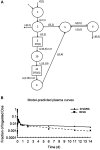Direct and indirect vitamin A supplementation strategies result in different plasma and tissue retinol kinetics in neonatal rats
- PMID: 27264735
- PMCID: PMC4959858
- DOI: 10.1194/jlr.M067165
Direct and indirect vitamin A supplementation strategies result in different plasma and tissue retinol kinetics in neonatal rats
Abstract
Many questions remain regarding vitamin A (VA) supplementation of infants. Herein we compared direct oral VA supplementation of the neonate and indirect treatment through maternal dietary VA (M-VA) treatment on VA status and kinetics in neonatal rats. Treatments included direct VA combined with retinoic acid (RA) [D-VARA; VA (6 mg/kg) + 10% RA, given orally to neonates on postnatal day (P)2 and P3] and indirect VA supplementation through increased M-VA, compared with each other and oil-treated neonates. [(3)H]retinol was administered orally to all neonates on P4. Plasma and tissue [(3)H]retinol kinetics were determined from 1 h to 14 days post-dosing. D-VARA versus placebo dramatically increased liver and lung retinol, but only in the first 8-10 days. In M-VA neonates, liver and lung VA increased progressively throughout the study. Compartmental modeling of plasma [(3)H]retinol showed that both D-VARA and indirect M-VA reduced retinol recycling between plasma and tissues. Compartmental models of individual tissues predicted that D-VARA stimulated the uptake of VA in chylomicrons to extrahepatic tissues, especially intestine, while the uptake was not observed in M-VA neonates. In conclusion, indirect maternal supplementation had a greater sustained effect than D-VARA on neonatal VA status, while also differentially affecting plasma and tissue retinol kinetics.
Keywords: WinSAAM; compartmental model; maternal dietary vitamin A; neonate.
Copyright © 2016 by the American Society for Biochemistry and Molecular Biology, Inc.
Figures




Similar articles
-
Retinol kinetics in unsupplemented and vitamin A-retinoic acid supplemented neonatal rats: a preliminary model.J Lipid Res. 2014 Jun;55(6):1077-86. doi: 10.1194/jlr.M045229. Epub 2014 Apr 7. J Lipid Res. 2014. PMID: 24711633 Free PMC article.
-
Compartmental modeling of whole-body vitamin A kinetics in unsupplemented and vitamin A-retinoic acid-supplemented neonatal rats.J Lipid Res. 2014 Aug;55(8):1738-49. doi: 10.1194/jlr.M050518. Epub 2014 Jun 9. J Lipid Res. 2014. PMID: 24914038 Free PMC article.
-
Vitamin A supplementation redirects the flow of retinyl esters from peripheral to central organs of neonatal rats raised under vitamin A-marginal conditions.Am J Clin Nutr. 2017 May;105(5):1110-1121. doi: 10.3945/ajcn.116.149039. Epub 2017 Mar 15. Am J Clin Nutr. 2017. PMID: 28298391 Free PMC article.
-
Vitamin A kinetics in neonatal rats vs. adult rats: comparisons from model-based compartmental analysis.J Nutr. 2015 Mar;145(3):403-10. doi: 10.3945/jn.114.204065. Epub 2014 Dec 24. J Nutr. 2015. PMID: 25540407 Free PMC article. Review.
-
Vitamin A supplementation and retinoic acid treatment in the regulation of antibody responses in vivo.Vitam Horm. 2007;75:197-222. doi: 10.1016/S0083-6729(06)75008-7. Vitam Horm. 2007. PMID: 17368317 Free PMC article. Review.
Cited by
-
Vitamin A Supplementation during Suckling and Postweaning Periods Attenuates the Adverse Metabolic Effects of Maternal High-Fat Diet Consumption in Sprague-Dawley Rats.Curr Dev Nutr. 2020 Jun 27;4(8):nzaa111. doi: 10.1093/cdn/nzaa111. eCollection 2020 Aug. Curr Dev Nutr. 2020. PMID: 32734136 Free PMC article. Review.
-
Vitamin A Status and Deposition in Neonatal and Weanling Rats Reared by Mothers Consuming Normal and High-Fat Diets with Adequate or Supplemented Vitamin A.Nutrients. 2020 May 18;12(5):1460. doi: 10.3390/nu12051460. Nutrients. 2020. PMID: 32443575 Free PMC article.
-
Our Current Dietary Reference Intakes for Vitamin A-Now 20 Years Old.Curr Dev Nutr. 2020 May 29;4(10):nzaa096. doi: 10.1093/cdn/nzaa096. eCollection 2020 Oct. Curr Dev Nutr. 2020. PMID: 32999953 Free PMC article. Review.
-
Vitamin A Requirements in Pregnancy and Lactation.Curr Dev Nutr. 2020 Aug 24;4(10):nzaa142. doi: 10.1093/cdn/nzaa142. eCollection 2020 Oct. Curr Dev Nutr. 2020. PMID: 32999954 Free PMC article. Review.
References
-
- Clagett-Dame M., and DeLuca H. F.. 2002. The role of vitamin A in mammalian reproduction and embryonic development. Annu. Rev. Nutr. 22: 347–381. - PubMed
-
- Altucci L., and Gronemeyer H.. 2001. Nuclear receptors in cell life and death. Trends Endocrinol. Metab. 12: 460–468. - PubMed
-
- Sommer A., and West K. P.. 1996. Vitamin A Deficiency: Health, Survival, and Vision. Oxford University Press, New York.
Publication types
MeSH terms
Substances
Grants and funding
LinkOut - more resources
Full Text Sources
Other Literature Sources
Medical

